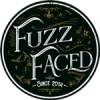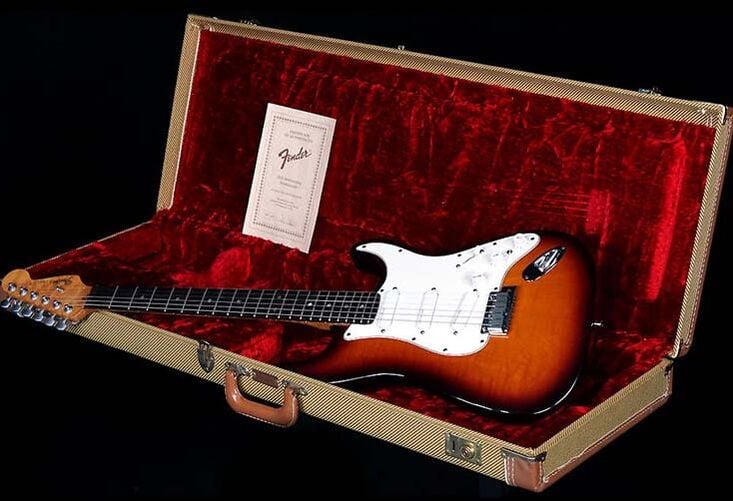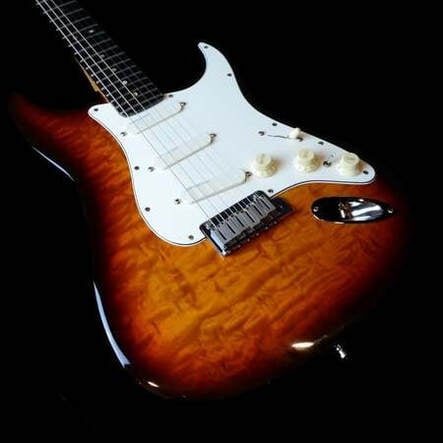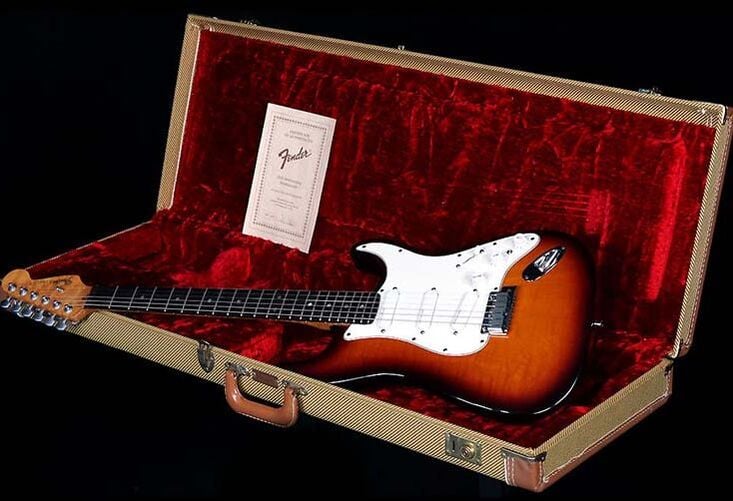In 1989, 35 years after the debut of the Stratocaster, Fender decided to release a new Anniversary guitar after the success of the 25th Anniversary Stratocaster and the 40th Anniversary Telecaster.
The Fender 35th Anniversary Stratocaster were built by a team composed of some Custom Shop apprentices, like Art Esparza and Ralph Esposito, headed by John Page and J.W. Black. However, although also Michael Stevens, Dan Smith, Fred Stuart, and Bruce Bolen in some way could be associated with the 35th Anniversary Stratocaster project, a lot of the decisions about the Anniversary specs, such as the use of some exotic tonewoods and Lace Sensor pickups, had been made by Marketing Team.
The Fender 35th Anniversary Stratocaster were built by a team composed of some Custom Shop apprentices, like Art Esparza and Ralph Esposito, headed by John Page and J.W. Black. However, although also Michael Stevens, Dan Smith, Fred Stuart, and Bruce Bolen in some way could be associated with the 35th Anniversary Stratocaster project, a lot of the decisions about the Anniversary specs, such as the use of some exotic tonewoods and Lace Sensor pickups, had been made by Marketing Team.
|
The 35th Anniversary Stratocaster sported an alder body with an extra thick two-piece book-matched highly figured maple top - quilt or flame - selected by the apprentice Brett Faust and finished in Antique Sunburst, whilst the back featured a transparent ruby red finish. The top was very thick, three-quarters of an inch thick or so, because he Custom Shop had not yet developed a top bending capability, and the thickness of the maple top and alder were very close to equal.
Fender patterned the 35th Anniversary Stratocaster to some extent after the Strat Plus and the Elite, and it would go on to serve a significant extent as the basis for the factory’s Strat Ultra unveiled in 1991. |
From the Strat Plus they borrowed Lace Sensor Silver pickups, brushed Fender/Schaller locking tuners, the Wilkinson Roller Nut, which was almost immediately replaced with a Teflon nut. From the Elite Stratocaster they borrowed the TBX, used also in the Strat Plus, and the MDX.
A mini toggle switch put between the tone knobs allowed the selection of the active or passive electronics, just like the push/pull switch used the very first Clapton pre-production Stratocaster and rejected on production models did.
Other features included a highly figured bird’s eye maple neck (often shaped by Herbie Gastelum), an ebony fretboard with 22 medium jumbo frets and abalone dot inlays, and a 2-Pivot Synchronized Tremolo.
A mini toggle switch put between the tone knobs allowed the selection of the active or passive electronics, just like the push/pull switch used the very first Clapton pre-production Stratocaster and rejected on production models did.
Other features included a highly figured bird’s eye maple neck (often shaped by Herbie Gastelum), an ebony fretboard with 22 medium jumbo frets and abalone dot inlays, and a 2-Pivot Synchronized Tremolo.
A touch of extra of extra elegance was lent by the unperforated pickups covers, which turned the pickguard area into a vast expanse of white, in contrast to the Antique Burst finish of the maple top.
500 units, all numbered on the back of the headstock above the original Custom Shop Oval Logo, were sold in a tweed case between 1989 and 1990, all by a certificate of authenticity signed either by John Page, Michael Stevens, or Bruce Bolen, which read “This special hand-crafted instrument commemorates the introduction of the Stratocaster in 1990.”
It is also interesting to mention what happened in Japan. Since Yamano, the official importer of Fender instruments made in the USA, didn't get enough of the official 35th Anniversary Strat, they ordered a limited number of very similar guitars to satisfy their Japanese customers.
500 units, all numbered on the back of the headstock above the original Custom Shop Oval Logo, were sold in a tweed case between 1989 and 1990, all by a certificate of authenticity signed either by John Page, Michael Stevens, or Bruce Bolen, which read “This special hand-crafted instrument commemorates the introduction of the Stratocaster in 1990.”
It is also interesting to mention what happened in Japan. Since Yamano, the official importer of Fender instruments made in the USA, didn't get enough of the official 35th Anniversary Strat, they ordered a limited number of very similar guitars to satisfy their Japanese customers.
Antonio Calvosa






